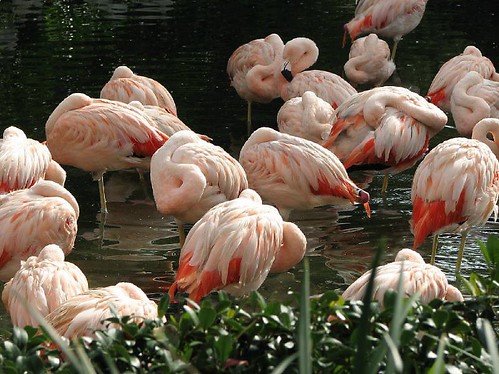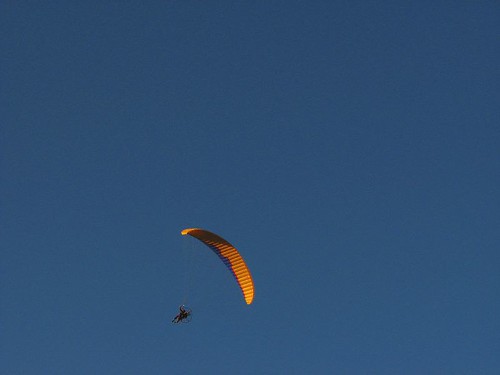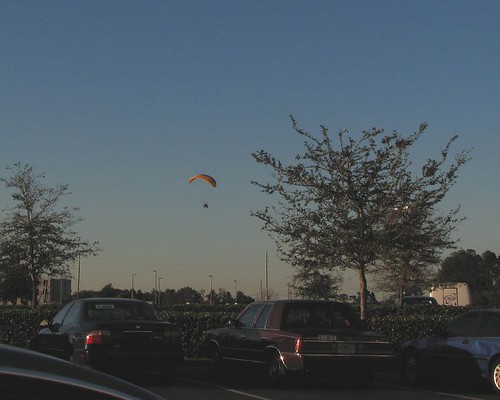My father never smoked a cigarette in his life, but he suffered from emphysema, most likely brought on by his commission in the military. He was commander of an artillery brigade during World War II. While he lived to age 84, he spent a good share of his senior years on hospital beds.
The years before he passed away, he often said to me, "If you had become a doctor, you would be treating me. You should have studied medicine." That time I was into information technology and marketing.
I didn't know then how to reply to my father's sentiment. But now I know. I would never have become a doctor, even if I tried real hard. I wasn't born with the brain cells to store volumes of medical information and readily access them for the patients I needed to treat. I wasn't even born with the stomach to stay calm and collected when a fellow human being screams in pain and gushes blood. I wasn't born with doctor genes.
Instead, I was born with a deep sense of curiosity and awe... at the universe around me. I might be curious enough to learn about health and sickness, and biology and mortality, maybe even psychiatry or surgery, but I'm also curious about thousands of other non-medical things.
At age 13, my curiosity in the kitchen led me to learn how to bake different types of cakes, cookies, and desserts. My mother couldn't stop me from pedaling the sewing machine and making my own clothes. I knew how to crochet, embroider, and make handicrafts. I think I was 16 when I learned how to mix cement and lay down bathroom tiles. Balancing on ladders to paint walls and window grills was as much an adventure for me as raising aquarium fishes, growing cacti, and solving jigsaw puzzles. Later on I found myself building wall shelves, practicing karate, and climbing mountains. Then computers and the Internet came along, opening up more stuff to delve into.
Much of this curiosity must have been handed down by my mother. She was half Spanish and big on discipline, but as she taught me how to set the table and entertain guests the old fashioned way, she also taught me never to fear new things. Read. Travel. Mingle. Observe. Absorb and appreciate as much as possible.
I wasn't born with the brains and guts of a doctor. I was born with a heart compelled to explore, find adventure, and learn new things everyday. My ailing father wouldn't have understood, but I think that if he could read me now, he would still be pleased.
Stories about my parents as my inspiration and role models are here:
http://www.oursimplejoys.com/inspiration.html
February 20, 2007
February 12, 2007
Flamingo A Go Go
In case you're not familiar with my Flickr photo site, username: MyRuby, I'd like to share a set of interesting shots that I took the last time I visited Seaworld.
There's a preserve at Seaworld where Caribbean Flamingos congregate. The other times I visited the park, the birds were loud and cackling at each other -- doing their bird thing. This time, they were all taking a nap.
I'm not sure what it is that inspires them to nap at the same time, at this particular time, but there they were, their long necks all curled up, their heads tucked under a wing, and, yes, standing on one leg. All of them!

So, while I was pretending to be a photographer there, getting bored at all the ball of feathers I was waiting to move around for some semblance of a flamingo photo shoot, two of them woke up and walked toward each other. They seemed to have awoken too early, and decided to confront each other.

"Did YOU wake me up?"
"Of course not! Maybe YOU woke me up!"
Then a third one woke up and approached the other two. Their heads came together, bobbed up and down, their rubbery necks almost twisting around one another. They looked like they were planning something. For a few seconds there, I imagined them hatching a plan (get it, "hatching"?! LOL!).

"Hey, Vinni... here's what we'll do. On my signal, we'll flap our wings and run about, cackling like crazy, you get that?! We'll wake 'em up and show 'em who's boss!"
Well, they didn't really do anything like that. After a few more minutes of bobbing heads and nudging each other, probably some macho territorial ritual, they walked away and slowly faded into the pond-ful of balls of feathers. At least I got a few neat-o photos of these exotic iconic birds.
Next time I visit Seaworld, I'll camp out next to the penguins.
HINT: click on photos for larger versions and to browse my Flickr site.
There's a preserve at Seaworld where Caribbean Flamingos congregate. The other times I visited the park, the birds were loud and cackling at each other -- doing their bird thing. This time, they were all taking a nap.
I'm not sure what it is that inspires them to nap at the same time, at this particular time, but there they were, their long necks all curled up, their heads tucked under a wing, and, yes, standing on one leg. All of them!

So, while I was pretending to be a photographer there, getting bored at all the ball of feathers I was waiting to move around for some semblance of a flamingo photo shoot, two of them woke up and walked toward each other. They seemed to have awoken too early, and decided to confront each other.

"Did YOU wake me up?"
"Of course not! Maybe YOU woke me up!"
Then a third one woke up and approached the other two. Their heads came together, bobbed up and down, their rubbery necks almost twisting around one another. They looked like they were planning something. For a few seconds there, I imagined them hatching a plan (get it, "hatching"?! LOL!).

"Hey, Vinni... here's what we'll do. On my signal, we'll flap our wings and run about, cackling like crazy, you get that?! We'll wake 'em up and show 'em who's boss!"
Well, they didn't really do anything like that. After a few more minutes of bobbing heads and nudging each other, probably some macho territorial ritual, they walked away and slowly faded into the pond-ful of balls of feathers. At least I got a few neat-o photos of these exotic iconic birds.
Next time I visit Seaworld, I'll camp out next to the penguins.
HINT: click on photos for larger versions and to browse my Flickr site.
February 8, 2007
Paramotoring
Back in the 70s, I overheard a couple of classmates talk about meeting up over some cliff to try out some new hang gliders. Wow! Hang gliding! I would've crashed their party if I weren't too busy memorizing lines for a drama presentation. Looking back, I should've just flown off a cliff considering how far I -didn't- go with that drama workshop.
Over the years, I've always contemplated on trying out some method of flying -- if not dead dropping with a parachute, maybe air-swimming about with a hang glider, or floating about with a motorized oversized kite.
A few days ago, we saw a guy doing just that -- floating about an open field under an oversized kite, with a huge fan and a motor strapped to his back. The fan and motor remind me of the airboats that maneuver through the everglades.
Motorized Paragliding... or Paramotoring... is what it's called. Here are a couple of photos I snapped in a hurry as we passed by.


It looks like a lot of fun -- you don't have to depend on the wind for your flight, and you don't have to jump off a plane, a cliff, or a tall building to get your thrill. Of course, you have to fork over most of your inheritance for the gear and the fuel, but hey, you gotta have some form of investment to literally fly high.
Want to learn more? See more photos? I found these two sites (I'm not affiliated with them in any way).
www.paragliding.us/paramotoring.htm
www.uptimal.com/club.html
Maybe one of these days.
Over the years, I've always contemplated on trying out some method of flying -- if not dead dropping with a parachute, maybe air-swimming about with a hang glider, or floating about with a motorized oversized kite.
A few days ago, we saw a guy doing just that -- floating about an open field under an oversized kite, with a huge fan and a motor strapped to his back. The fan and motor remind me of the airboats that maneuver through the everglades.
Motorized Paragliding... or Paramotoring... is what it's called. Here are a couple of photos I snapped in a hurry as we passed by.


It looks like a lot of fun -- you don't have to depend on the wind for your flight, and you don't have to jump off a plane, a cliff, or a tall building to get your thrill. Of course, you have to fork over most of your inheritance for the gear and the fuel, but hey, you gotta have some form of investment to literally fly high.
Want to learn more? See more photos? I found these two sites (I'm not affiliated with them in any way).
www.paragliding.us/paramotoring.htm
www.uptimal.com/club.html
Maybe one of these days.
February 2, 2007
Cleaning Dried Eucalyptus
It was time to clean my dried flower arrangements. The last time I cleaned the one in the bathroom was... never. Not that they didn't really need any cleaning, but because it's a big arrangement with assorted flowers and reeds that it would really require a considerable block of time to clean them.
You wish you could just throw them in a bucket of sudsy water, shwish them around, pull them out, and shake them dry. But you can't. You have to hold each stalk and gently brush off the dust and dirt. You could lose a dried flower or break a twig here and there, but it's part of the cleaning process.
Most of my arrangements are eucalyptus -- I like them for their resiliency. The fragrance is distinct, although I've encountered some that get nasty after a while, smelling like old socks -- I think some driers mess with additive fragrances. But, dried eucalyptus really last forever.
So, I picked up my trusty soft-bristled paintbrush, took a seat out in the patio, dumped all the preserved eucalyptus branches, dried wheat stalks, mini-bamboos, twisted cane sticks, and dehydrated flowers on the round table, and went to work.
It took me about an hour to clean three floral arrangements. I re-arranged only enough for one vase. The rest, I laid out in an oversized shirt box to store for future use. I could've thrown them away... they're dead anyway. But I'm a certified card-carrying packrat, er, conservationist-recycler, who believes that every item in this world could potentially be a component of a revolutionary art piece. Okay, I'm a packrat. But look, these preserved eucalyptus leaves still look good after... so many years!
Eucalyptus leaves are particularly prone to dust... they attract dust... or more like dust clings to them for dear life. That's because the leaves and stems are naturally oily. Eucalyptus is preserved by letting them absorb water spiked with glycerin, an ingredient in the soap-making process. Effectively, the branches are "dry" but remain oily. Therefore, it requires a little patience to clean these branches because you have to brush both sides of each leaf to really do a good job. Blowing or "swiffer"-ing won't do. Well, consider it a zen experience -- not unlike pruning and shaping bonsai. Or, just like you polish your silver, you brush your dried eucalyptus.
Here are some photos I took during my zen moments:


You wish you could just throw them in a bucket of sudsy water, shwish them around, pull them out, and shake them dry. But you can't. You have to hold each stalk and gently brush off the dust and dirt. You could lose a dried flower or break a twig here and there, but it's part of the cleaning process.
Most of my arrangements are eucalyptus -- I like them for their resiliency. The fragrance is distinct, although I've encountered some that get nasty after a while, smelling like old socks -- I think some driers mess with additive fragrances. But, dried eucalyptus really last forever.
So, I picked up my trusty soft-bristled paintbrush, took a seat out in the patio, dumped all the preserved eucalyptus branches, dried wheat stalks, mini-bamboos, twisted cane sticks, and dehydrated flowers on the round table, and went to work.
It took me about an hour to clean three floral arrangements. I re-arranged only enough for one vase. The rest, I laid out in an oversized shirt box to store for future use. I could've thrown them away... they're dead anyway. But I'm a certified card-carrying packrat, er, conservationist-recycler, who believes that every item in this world could potentially be a component of a revolutionary art piece. Okay, I'm a packrat. But look, these preserved eucalyptus leaves still look good after... so many years!
Eucalyptus leaves are particularly prone to dust... they attract dust... or more like dust clings to them for dear life. That's because the leaves and stems are naturally oily. Eucalyptus is preserved by letting them absorb water spiked with glycerin, an ingredient in the soap-making process. Effectively, the branches are "dry" but remain oily. Therefore, it requires a little patience to clean these branches because you have to brush both sides of each leaf to really do a good job. Blowing or "swiffer"-ing won't do. Well, consider it a zen experience -- not unlike pruning and shaping bonsai. Or, just like you polish your silver, you brush your dried eucalyptus.
Here are some photos I took during my zen moments:


Subscribe to:
Posts (Atom)